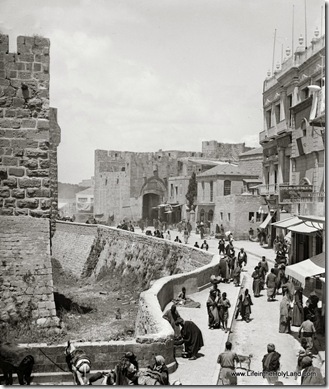Recently a friend alerted me to a discussion online about major renovations to be started soon in the vicinity of Jaffa Gate. Among other things, this will close the gate off to vehicular traffic. If they dig anything up, chances are very high that they’ll find something of significance, which will slow their progress down even further. A source in Jerusalem relates the following:
1. The gate is being closed to car traffic due to road renovations.
2. They may leave one lane open for one-way traffic.
3. The gate is supposed to close soon after Succot (which ended a few days ago).
4. A Muslim policeman “who isn’t trustworthy” said that the gate would NOT reopen ever.
5. Shop owners are concerned about how they will receive supplies.
This is not the first time the authorities have done major work on the road here.
 Jaffa Gate area from east, with Crusader moat of Citadel visible in foreground. Date of photograph: 1898-1907. From the new Jerusalem CD.
Jaffa Gate area from east, with Crusader moat of Citadel visible in foreground. Date of photograph: 1898-1907. From the new Jerusalem CD.
5 thoughts on “Jaffa Gate Closure”
Todd, recent reports about happenings at various gates around Jerusalem, combined with reflections on last year's announcement about Qeiyafa's 2nd gate, have me wondering. In your commentary last year (here's a link for convenience), you & Prof. Garfinkel said it's:
"the only city from the Iron Age in this region ever found with two gates"
"the largest ever found from the Iron Age"
"not only are there very few early 10th-century fortifications in Israel, I don’t know of any with two gates"
"we know that there are no other sites in the area that had two gates"
How many gates does Jerusalem have, & do any of them date to the Iron Age?
G.M. – your questions reflect good observations. Portions of up to four gates have been excavated that may be dated to the Iron Age: 1) the "Israelite tower" excavated by Nahman Avigad which may be connected to the Middle Gate of Jeremiah 39:3; 2) the "Water Gate" excavated by Eilat Mazar; 3) the "Water Gate" excavated by Kathleen Kenyon; and 4) the "Valley Gate" excavated by Crowfoot and Fitzgerald.
The identification of #2 is doubted by many. The dating of #4 is difficult. The #3 gate was built in the Middle Bronze Age but probably continued in use until the middle of Iron II.
A better way to determine how many gates there were in the Iron Age is to read Nehemiah's account of the destroyed city that he was going to rebuild. There are many!
Jerusalem is, however, in a different category than Qeiyafa. I don't think Qeiyafa was in Garfinkel's thinking in these comparisons.
Ah, excellent info, Todd! So since Jerusalem has at least 2 Iron Age gates, & since "Shaaraim" can mean "Gates" plural (like Bill's name) or "2 Gates" or "Double-Gate", a foreign visitor passing by from the north could just as easily have referred to Jerusalem as Shaaraim before learning its real name. Then, continuing southward, they might have passed by another Shaaraim, & later exclaimed, "These people ain't very creative … I just passed 2 Shaaraims, 2 Socohs, & 2 Ziphs…"
The Jaffa Gate is currently open to one-way traffic entering the gate. Cars may then drive along the road which skirts the Turkish walls of the city towards the Western Wall and out through the Dung Gate. I was just at the site this evening and they are already hitting walls from earlier periods, though I'm not sure from which period!
GM: I realize you posted a while ago, but your question about walls and gates because it completely depends on the period. The CURRENT walls of the "Old City" are from the Turkish period (1538 CE). The city during the Bronze and Iron Age was on a different angle (the southernmost part, the Temple Mount was actually the most northern part). During the 8th Century BCE the city was expanded to the Western Hill (includes part of the current Armenian Quarter, Mount Zion, and the Jewish Quarter). It was rebuilt along similar lines after the return from Babylon and expanded during the Roman period. In 70 CE the Romans destroyed the city completely and built a new one with a new name (Aelia Capitolina). The city remained under Roman rule until 686 which the Muslim's conquered the city. Following the back and forth of the Crusades, the city was without walls until Suleiman the Magnificent was told in a dream to rebuild the walls in 1538 CE.
There are definitely Iron Age remains (some walls, monumental structures, gates) which have been found in the city. Who knows what the current excavations will find along the slopes of the "City of David" and the new excavation at the Jaffa Gate!
Thank you, Sarah!